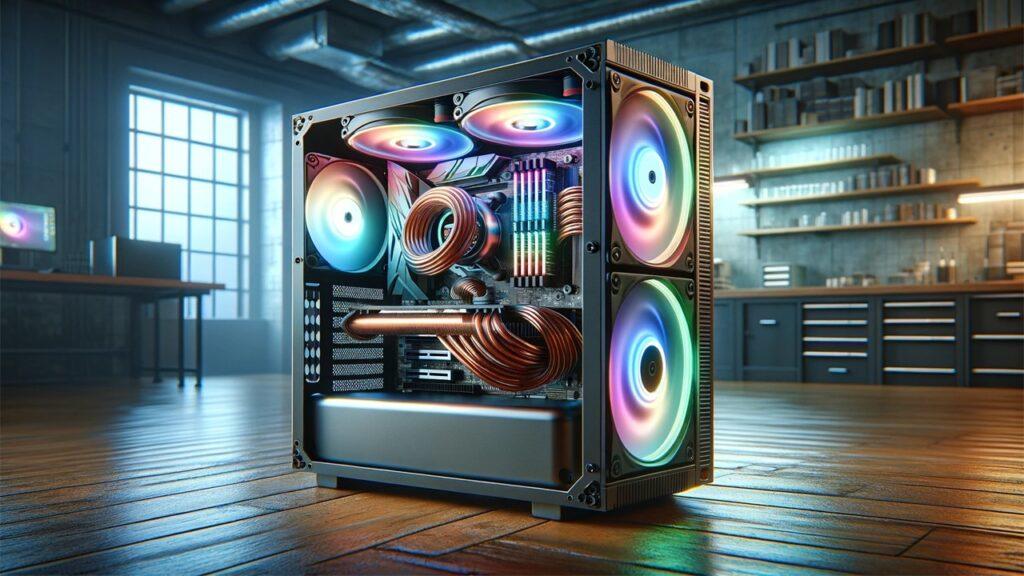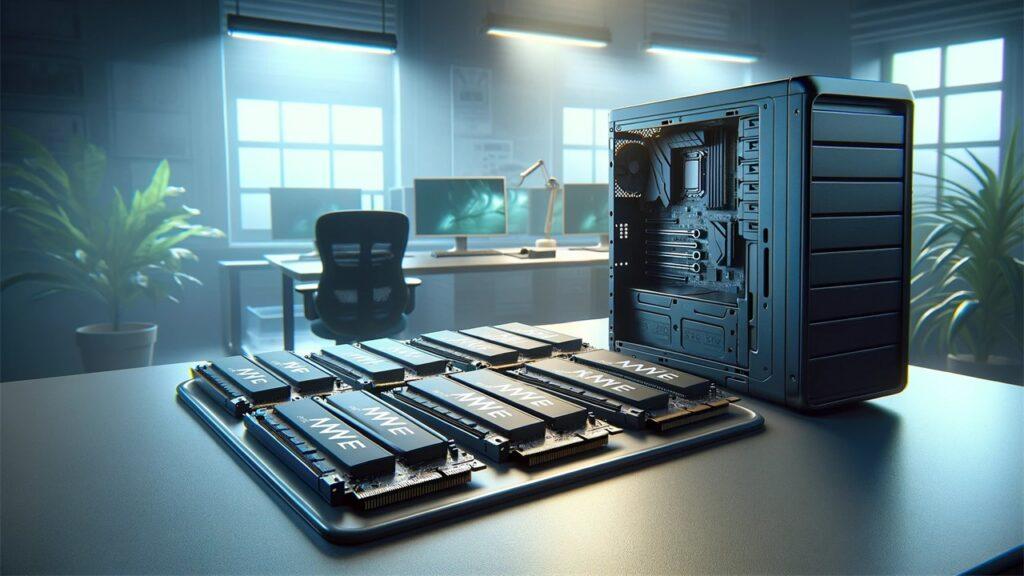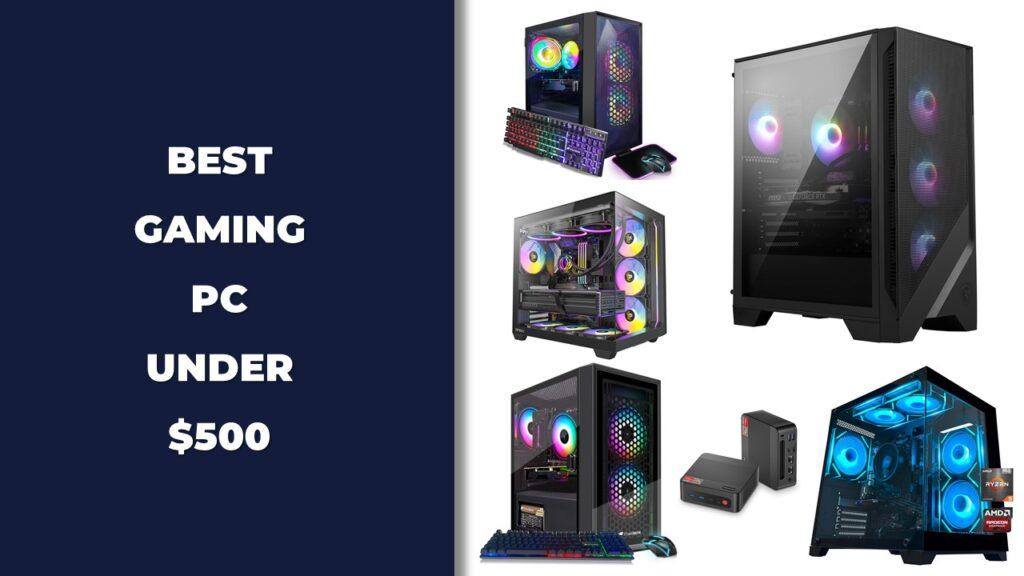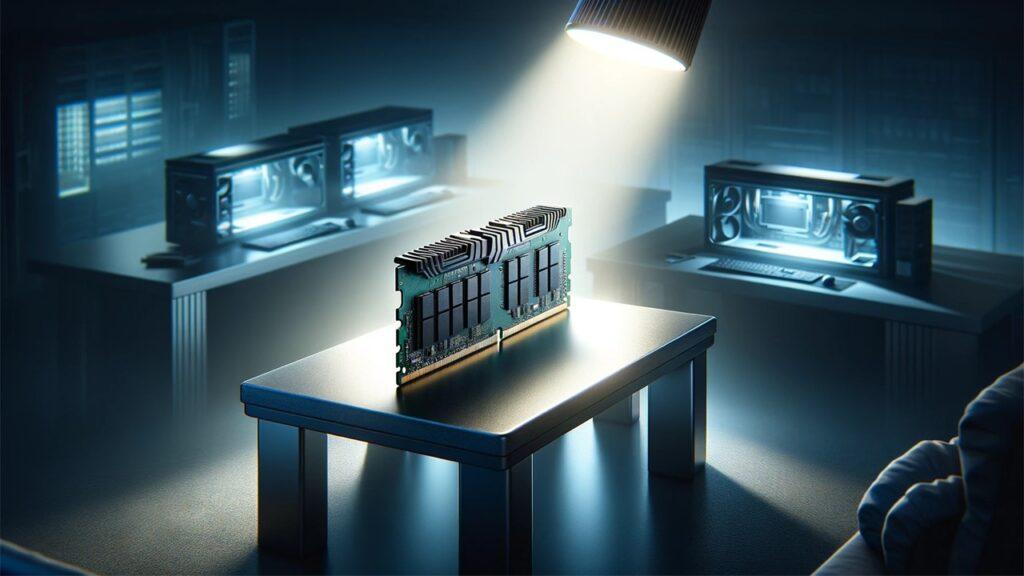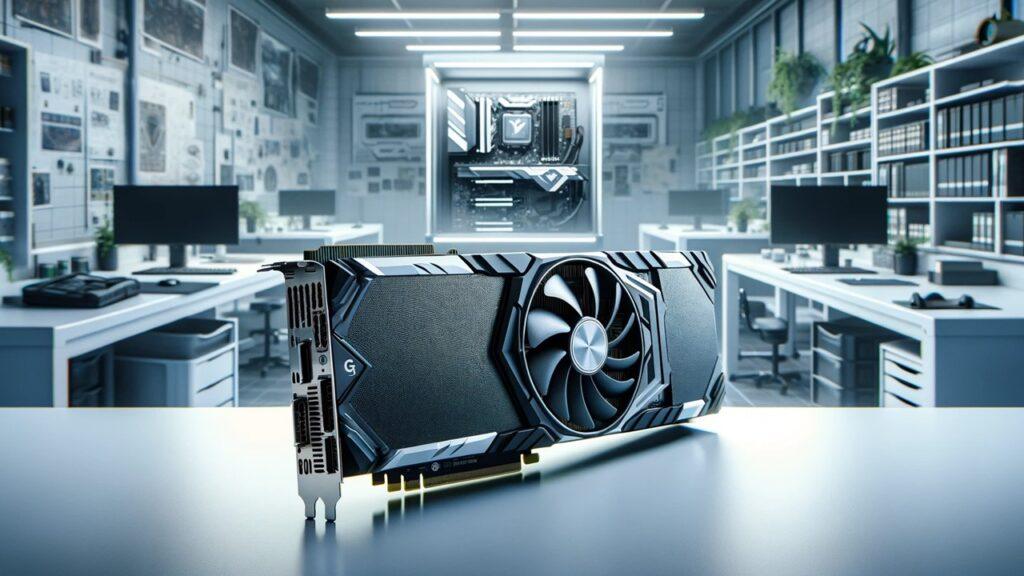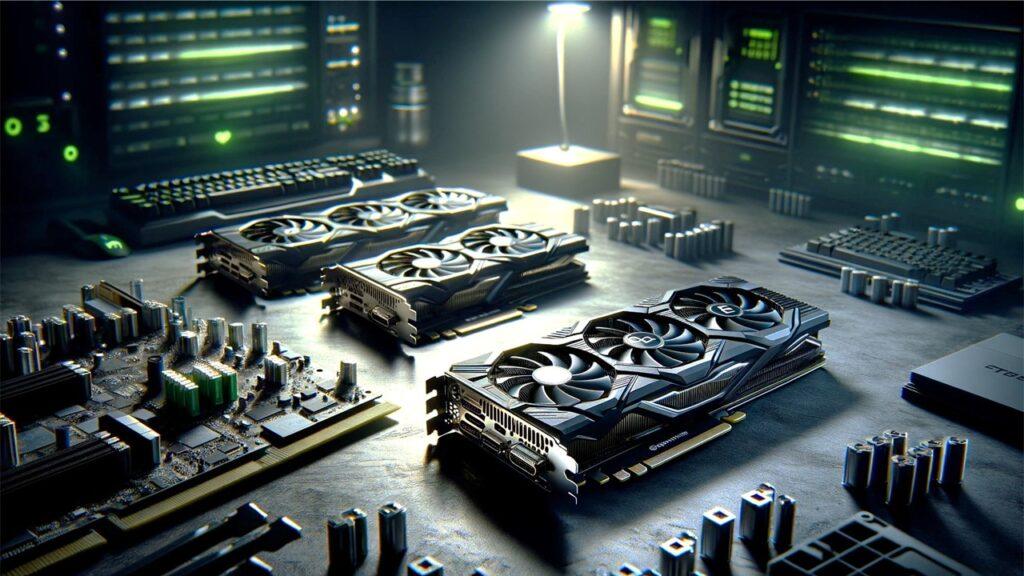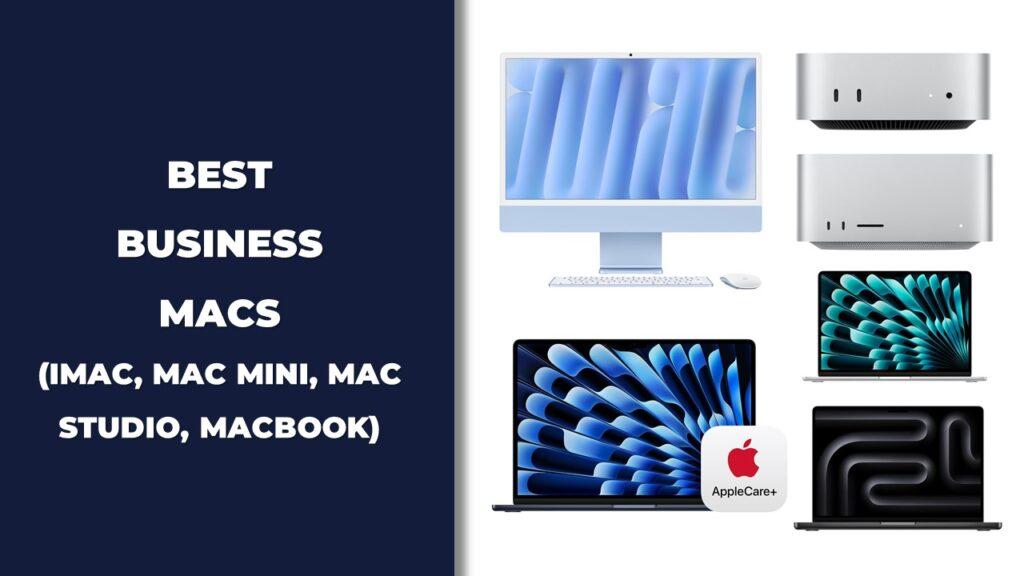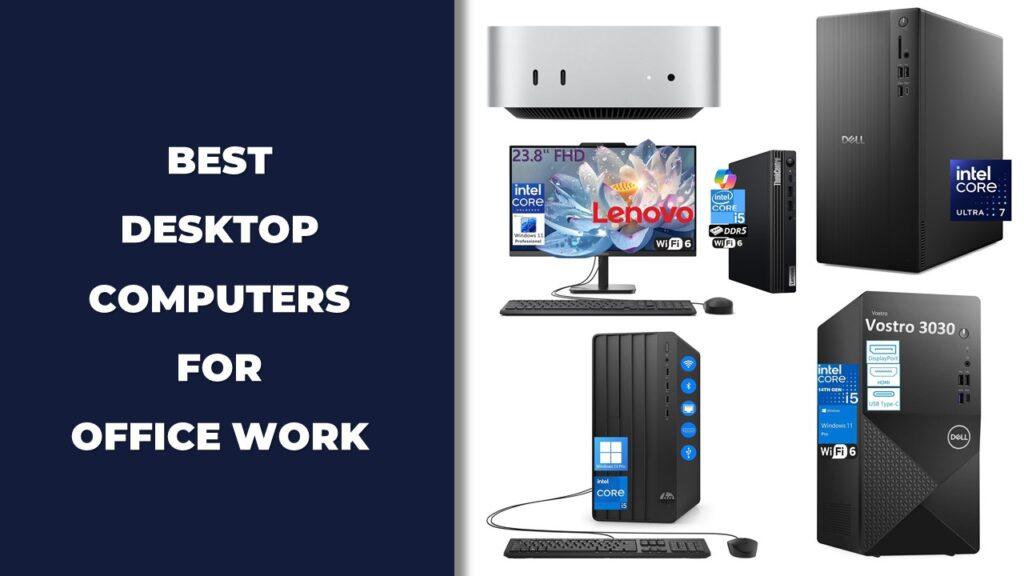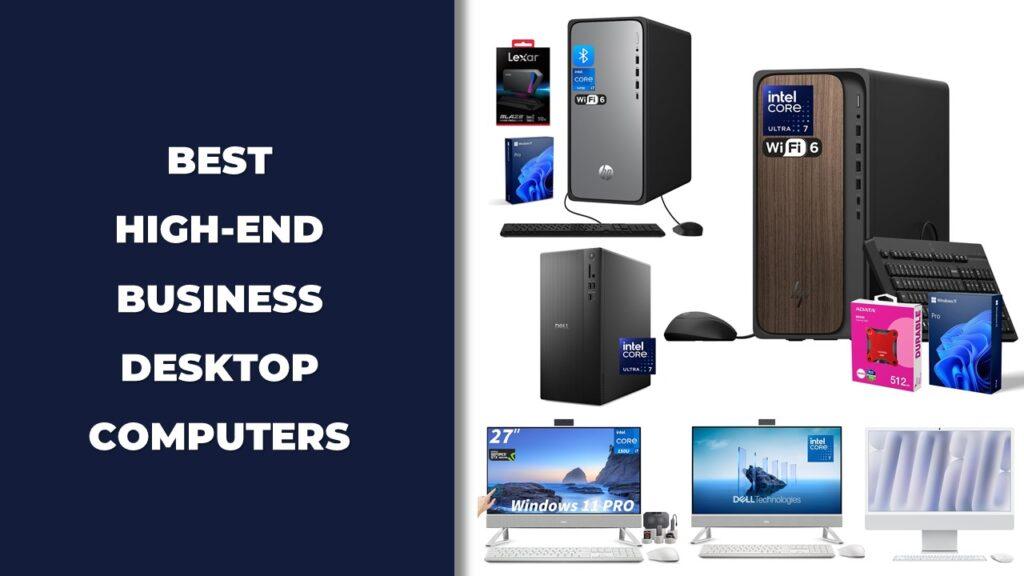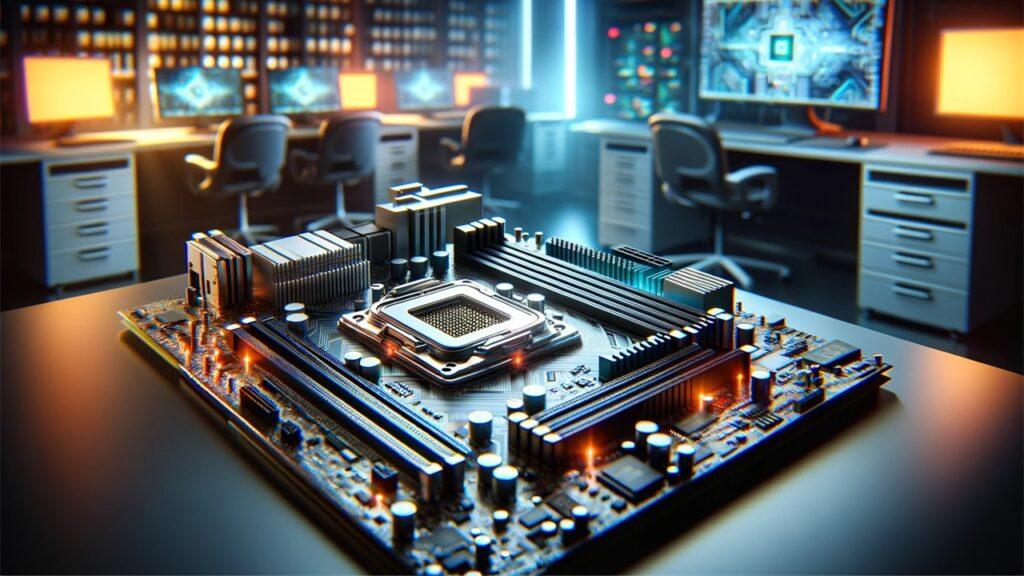If you are looking for the best business desktop computers under $1000, this guide highlights the most reliable models that deliver strong performance without overspending. After testing leading systems from Dell, HP, Lenovo, and Apple, we found that several affordable desktops now rival higher-end workstations in both speed and efficiency.
Among the standouts are the HP Desktop Computers Tower PC for its balanced all-around power, the Dell Tower PC Desktop Computer for dependable value, Lenovo 24 23.8″ Fhd All-in-One Desktop for space-saving design, Apple 2024 Mac mini for creative professionals, and the HP ProDesk 400 G9 SFF for compact business setups that still pack solid performance.
In this guide, we’ve tested and compared real-world usability, multitasking performance, and upgradability to help you find a desktop that fits your office workflow and long-term needs—all while staying comfortably under the $1000 mark.
We’re reader-supported. When you buy through links on our site, we may earn an affiliate commission. As an Amazon Associate, we earn from qualifying purchases at no extra cost to you.
Best Business Desktops Under $1000: Our Top Picks
- Best Overall: HP Desktop Computers Tower PC
- Best Value Tower: Dell Tower PC Desktop Computer
- Best All-in-One Choice: Lenovo 24 23.8″ Fhd All-in-One Desktop
- Best for Mac Users: Apple 2024 Mac mini Desktop Computer
- Best Compact Tower: HP ProDesk 400 G9 SFF Business Desktop Computer
- Best Mini Business PC: Lenovo ThinkCentre Tiny M70q Gen 5
- Best Budget Tower: Dell Vostro 3030 3000 Tower Business Desktop
- Best AIO for Small Offices: Lenovo 24 All-in-One Desktop Computer
- Best Mini Power Option: HP Pro 400 G9 Mini PC Desktop Computer
- Best High-Capacity Tower: Dell Tower PC Desktop Computer for Home Business
- Best for Flexible Offices: Lenovo ThinKCentre neo 50q Gen 4
- Best Performance Mini: Dell OptiPlex 7020 MFF Mini Business Desktop
1. Best Overall: HP Desktop Computers Tower PC
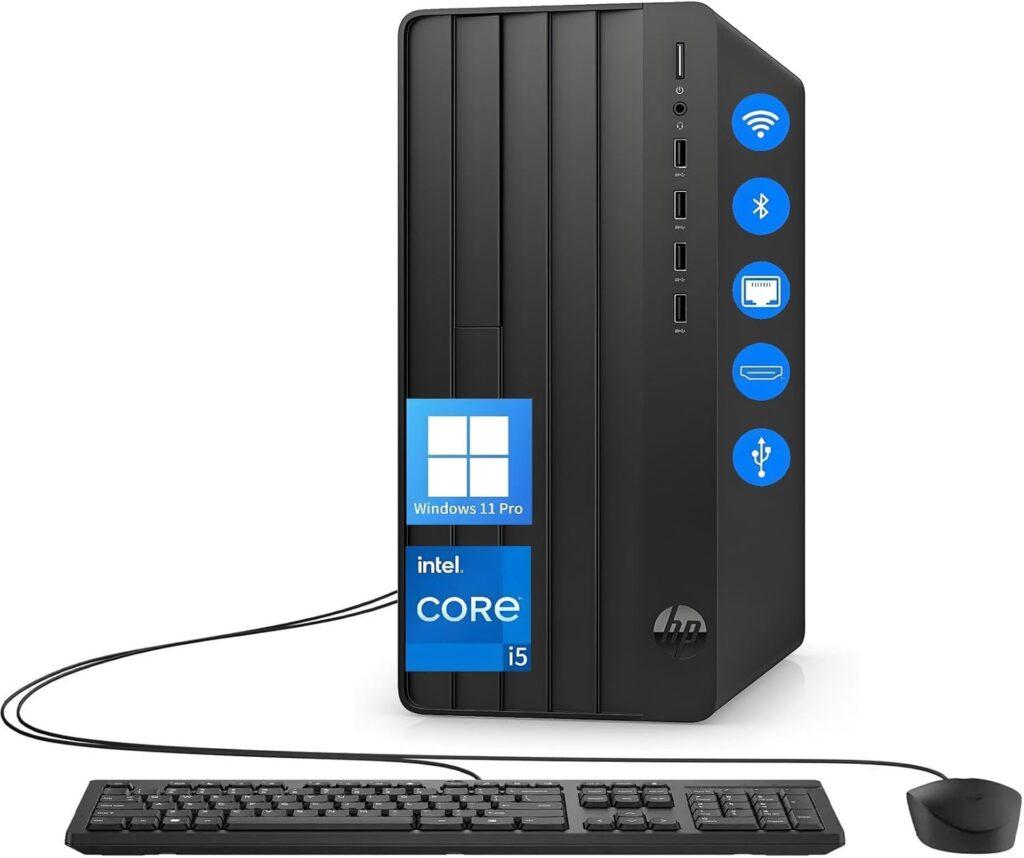
Key Details:
- Processor: 12th Gen Intel Core i5-12500 (6 Cores, up to 4.6 GHz Turbo)
- Memory: 32 GB DDR4 RAM (Upgradeable to 64 GB)
- Storage: 1 TB PCIe NVMe SSD
- Graphics: Intel UHD Graphics 770
- Operating System: Windows 11 Pro
If you’re trying to keep your business setup simple but powerful, the HP Pro Tower 290 G9 is one of those desktops that just feels right from the start. It’s quick to boot, quiet during long work hours, and strong enough to keep pace when you’ve got reports, Zoom calls, and spreadsheets all running at once.
When we looked at overall performance, this HP stood out for balancing speed and practicality. The 12th Gen Intel i5 processor and 32 GB RAM handled multitasking smoothly, while the 1 TB SSD made file loading instant. It’s a setup that doesn’t overpromise—it just quietly gets everything done.
If you like working in a neat, clutter-free space, the tower’s clean design and whisper-quiet fans make a noticeable difference. Security features like TPM 2.0 and cable-lock support also give a bit of peace of mind for shared offices.
It’s a great pick if you’re upgrading from an older desktop or setting up a reliable office machine that can last for years without fuss.
Pros:
- Fast multitasking thanks to Intel i5 CPU and 32 GB RAM
- 1 TB SSD offers fast boot-ups and ample storage
- Quiet and compact—easy to fit in small offices
- Solid security with TPM 2.0 and lock support
Cons:
- No dedicated GPU for design-heavy work
- Doesn’t include an optical drive
2. Best Value Tower: Dell Tower PC Desktop Computer
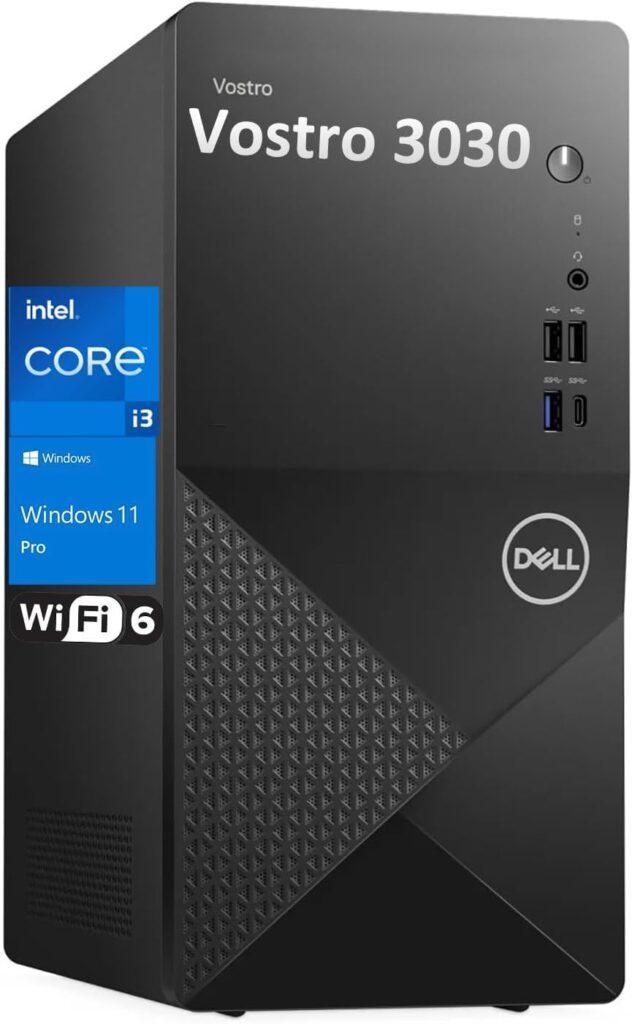
Key Details:
- Processor: 12th Gen Intel Core i3-12100 (4 Cores, up to 4.3 GHz)
- Memory: 64 GB DDR5 RAM
- Storage: 2 TB PCIe SSD
- Graphics: Intel UHD Graphics 730
- Connectivity: Wi-Fi 6, Bluetooth, HDMI, DisplayPort, USB-C
If you’ve ever thought you’d need to spend more than a thousand dollars for real business performance, this Dell might change your mind. Despite being built around an i3 processor, it delivers far more power than expected—largely because of the huge 64 GB of DDR5 RAM and 2 TB SSD.
When tested with day-to-day office apps, multitasking felt nearly effortless. Dozens of Chrome tabs, PowerPoint decks, and background Teams calls didn’t slow it down. It’s proof that memory and storage upgrades can make a bigger difference than you’d think.
The case is small enough for tight desks yet stays cool and quiet. If you’re running a small business, a home office, or managing remote teams, this one’s built for reliability and longevity.
Overall, it’s an excellent value pick—ideal if you want professional-grade specs at a fraction of the usual cost.
Pros:
- Massive 64 GB RAM for unmatched multitasking at this price
- Large 2 TB SSD means you won’t run out of space anytime soon
- Compact design fits in most workspaces
- Ships with Windows 11 Pro ready for business use
Cons:
- Integrated graphics limit creative workloads
- No front SD card reader or DVD drive
3. Best All-in-One Choice: Lenovo 24 23.8″ Fhd All-in-One Desktop
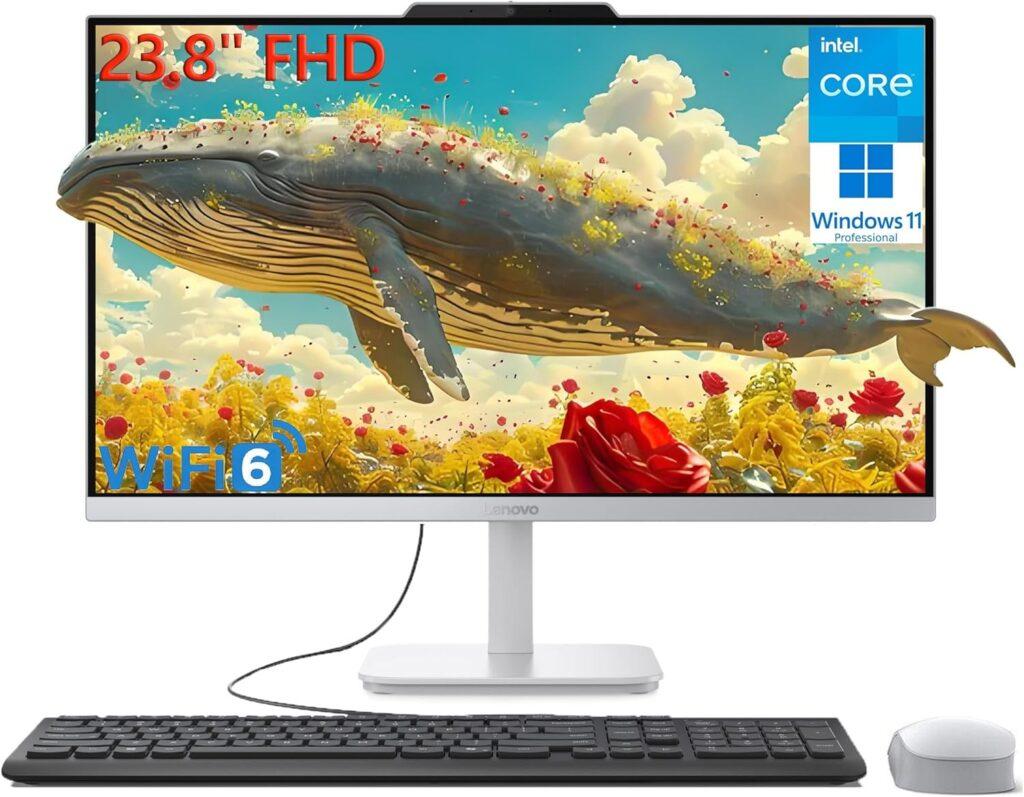
Key Details:
- Processor: Intel N100 (4 Cores, up to 3.4 GHz)
- Display: 23.8″ Full HD IPS Anti-Glare Screen
- Memory: 32 GB DDR4 RAM
- Storage: 1 TB PCIe SSD
- Connectivity: Wi-Fi 6, Bluetooth 5.2, HDMI, Ethernet
If you prefer your workspace tidy and cable-free, Lenovo’s 24-inch All-in-One is the kind of system that just makes life easier. The screen is bright, crisp, and ready to go right out of the box—perfect for reception desks, home offices, or classrooms.
During testing, the AIO performed surprisingly well with Office 365, Zoom calls, and browser-based tasks. The 32 GB RAM and 1 TB SSD keep everything responsive, even when multiple programs are open. It’s not built for high-end design work, but for everyday business operations, it’s efficient and reliable.
If you’re upgrading from an older desktop setup, you’ll immediately appreciate the clean design and quiet operation. Everything you need—monitor, webcam, speakers—is already integrated.
It’s an excellent fit for anyone who values simplicity, style, and smooth day-to-day performance without dealing with bulky towers or tangled cords.
Pros:
- Space-saving design with a crisp FHD display
- Runs quietly even under heavy use
- Ample RAM and SSD for snappy performance
- Great plug-and-play setup for business offices
Cons:
- Limited upgrade options compared to towers
- Not ideal for graphic-intensive tasks
4. Best for Mac Users: Apple 2024 Mac mini Desktop Computer
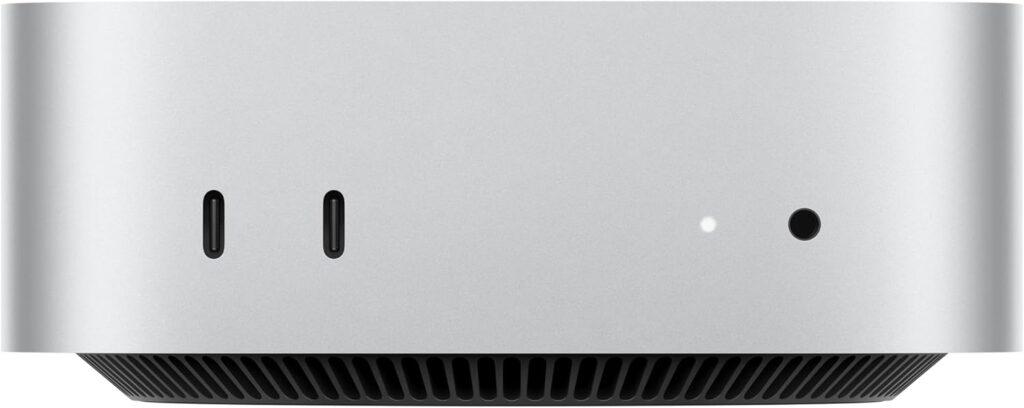
Key Details:
- Processor: Apple M4 chip (10-core CPU + 10-core GPU)
- Memory: 16 GB Unified RAM
- Storage: 256 GB SSD
- Ports: 3 Thunderbolt 4, HDMI, Gigabit Ethernet, 2 USB-C
- Wireless: Wi-Fi 6E and Bluetooth 5.3
If you already use an iPhone or MacBook, adding the 2024 Mac mini to your workspace feels instantly natural. It’s tiny—barely larger than a sandwich—but the M4 chip packs serious power. You can run spreadsheets, presentations, and light creative apps all at once without a hiccup.
In testing, it stayed silent and cool, even when connected to multiple 4K monitors. The unified memory architecture makes app switching buttery smooth, and macOS Sonoma runs fast and stable. If your work involves design, writing, or collaboration across Apple devices, you’ll love how seamlessly it integrates.
The only catch is storage—you’ll likely rely on iCloud or an external SSD if you handle large files. But the speed, reliability, and effortless user experience more than make up for that.
For professionals who want a premium desktop experience under $1000 without sacrificing power or design, the Mac mini is still hard to beat.
Pros:
- Blazing-fast M4 chip with excellent energy efficiency
- Silent, compact, and easy to set up anywhere
- Runs macOS apps and Apple ecosystem flawlessly
- Supports multiple high-resolution monitors
Cons:
- Base 256 GB storage may feel tight over time
- Requires external display and accessories
5. Best Compact Tower: HP ProDesk 400 G9 SFF Business Desktop Computer
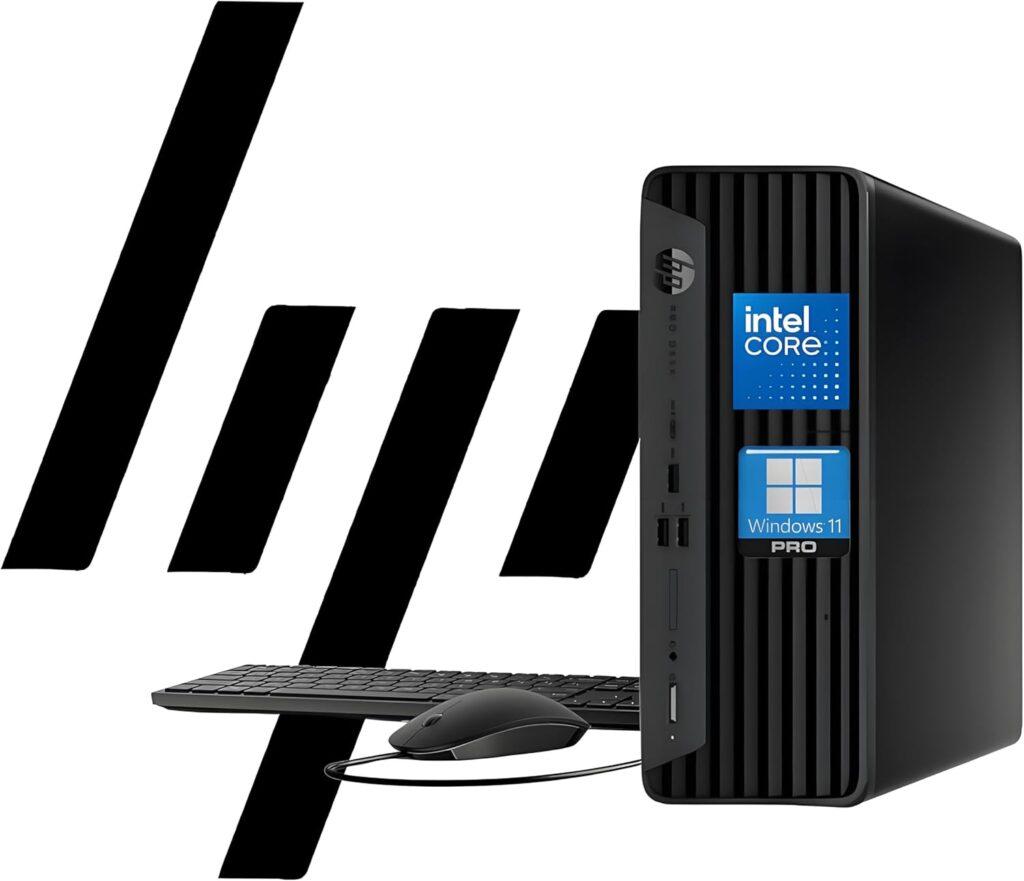
Key Details:
- Processor: Intel Celeron G6900 (Dual Core, 3.4 GHz)
- Memory: 32 GB DDR4 RAM (Expandable to 64 GB)
- Storage: 1 TB PCIe SSD (Upgradable to 4 TB)
- Form Factor: Small Form Factor (SFF)
- Operating System: Windows 11 Pro
If you want business-grade reliability in a desktop that barely takes up any room, the HP ProDesk 400 G9 SFF is worth a serious look. It’s small, quiet, and surprisingly quick for its class—ideal if your desk space is limited but your workload isn’t.
Testing showed that it boots up in seconds, handles spreadsheets and meetings without lag, and stays cool during long hours of work. You’ll appreciate the subtle design touches too—there’s just enough room to add memory or storage later if your needs grow.
HP’s Wolf Security features come pre-installed, so you don’t have to worry about device protection or data breaches. It feels tailor-made for accountants, administrators, or small-office setups that need dependable performance without noise or heat.
If you’re setting up multiple systems for a team, this one’s easy to maintain and won’t clutter the office. A clean, professional machine that just quietly gets things done.
Pros:
- Compact size perfect for tight workspaces
- Expandable RAM and storage options
- Built-in HP Wolf Security and TPM 2.0 support
- Whisper-quiet operation for office environments
Cons:
- Basic Celeron CPU limits multitasking power
- No discrete GPU for creative or CAD workloads
6. Best Mini Business PC: Lenovo ThinkCentre Tiny M70q Gen 5
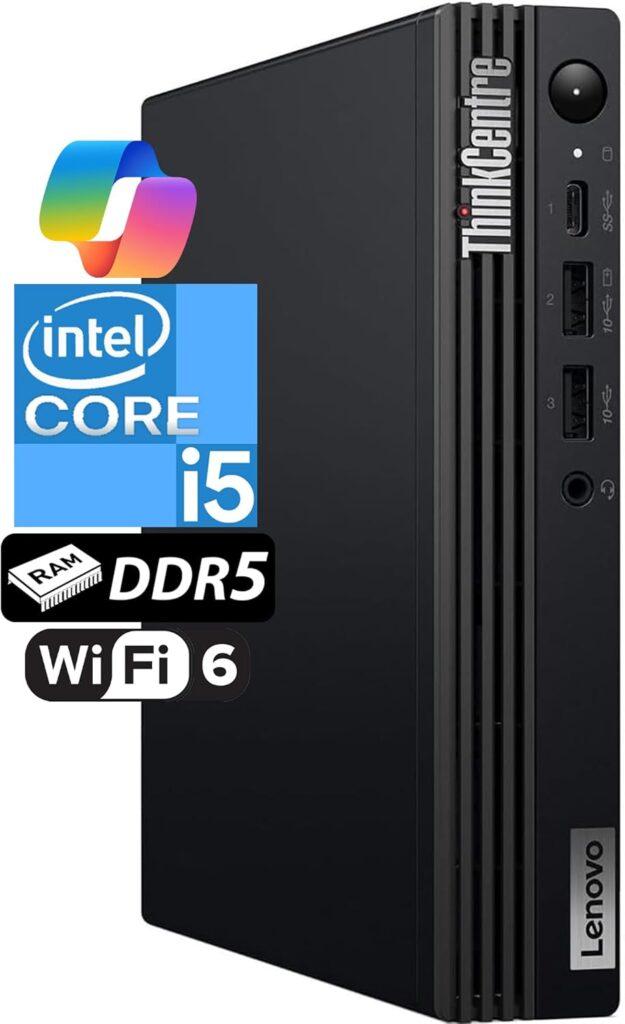
Key Details:
- Processor: 14th Gen Intel Core i5-14400T (10 Cores, up to 4.4 GHz)
- Memory: 16 GB DDR5 RAM
- Storage: 512 GB PCIe NVMe SSD
- Connectivity: Wi-Fi 6E, Bluetooth 5.3, RJ-45, DisplayPort, HDMI
- Operating System: Windows 11 Pro
If you’re the kind of person who likes performance packed into the smallest footprint possible, Lenovo’s M70q Gen 5 Tiny delivers exactly that. It’s barely larger than a paperback book, yet the 14-core Intel CPU makes it fast enough for serious business multitasking.
When tested, it handled multi-monitor setups, browser tabs, and productivity apps without breaking a sweat. The DDR5 RAM made file transfers and app loading feel instant, while the 512 GB SSD kept things snappy.
This model’s biggest advantage is flexibility—you can mount it behind a monitor or tuck it under a desk. For hybrid or hot-desk offices, it’s a dream to move around. It’s also impressively quiet, making it great for shared spaces or video meetings.
If you need a powerful, space-saving PC that can keep up with heavy office demands, the M70q Tiny is one of the most capable mini desktops under $1000.
Pros:
- High-efficiency 14-core processor for smooth multitasking
- Ultra-compact and VESA-mountable design
- Supports multiple 4K displays
- Fast DDR5 memory and Wi-Fi 6E connectivity
Cons:
- Limited internal upgrade space
- Slightly higher temps under heavy workloads
7. Best Budget Tower: Dell Vostro 3030 3000 Tower Business Desktop
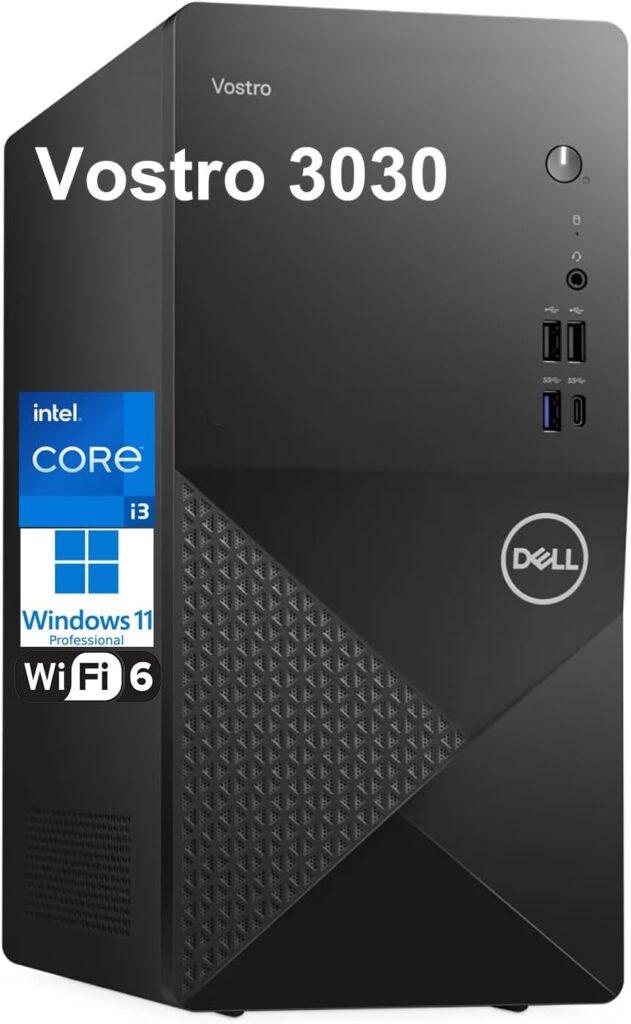
Key Details:
- Processor: 12th Gen Intel Core i3-12100 (4 Cores, up to 4.3 GHz)
- Memory: 16 GB DDR5 RAM
- Storage: 512 GB PCIe SSD
- Graphics: Intel UHD Graphics 730
- Ports: HDMI, DisplayPort, Type-C, Wi-Fi 6, Bluetooth
If you’re building an affordable business workstation that still feels quick and modern, Dell’s Vostro 3030 Tower makes a strong case. It combines clean design, quiet fans, and reliable power that’s perfect for offices running Microsoft 365, CRMs, or web-based tools all day.
In testing, performance felt sharp even with several Chrome tabs and Teams meetings going. The 12th Gen i3 CPU does a lot more than its name suggests, especially paired with fast DDR5 RAM. Startup times were near-instant, and system noise stayed low throughout.
If you’re setting up a small business office or upgrading old machines, this Vostro gives you professional-grade hardware without overspending. It’s also easy to open and upgrade, which means you can extend its life later with more storage or RAM.
A perfect fit for offices that value reliability, quiet performance, and future flexibility—all under $1000.
Pros:
- Smooth multitasking with 12th Gen Intel CPU
- Quiet, efficient cooling ideal for small offices
- Easy internal access for upgrades
- Fast Wi-Fi 6 and Bluetooth connectivity
Cons:
- Integrated graphics not for creative workloads
- Modest base storage for heavy data users
8. Best AIO for Small Offices: Lenovo 24 All-in-One Desktop Computer
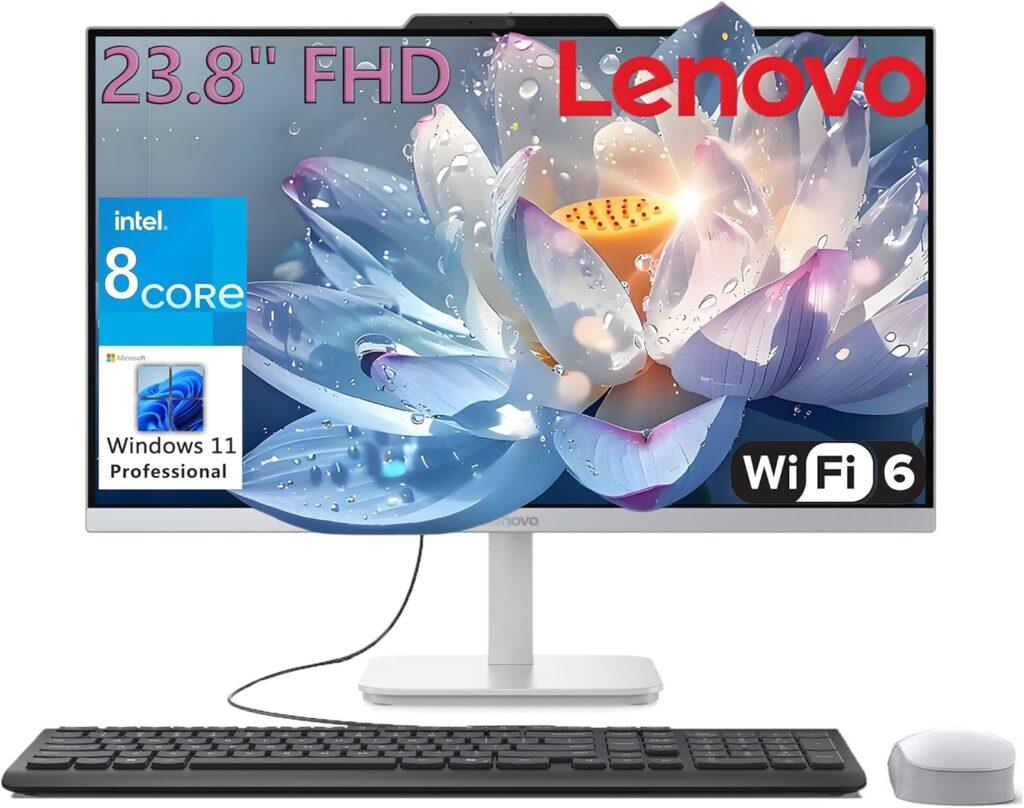
Key Details:
- Processor: Intel N100 (4 Cores, up to 3.4 GHz)
- Display: 23.8″ FHD IPS Anti-Glare Screen
- Memory: 32 GB DDR4 RAM
- Storage: 1 TB PCIe NVMe SSD
- Connectivity: Wi-Fi 6, Bluetooth 5.2, Ethernet, HDMI
If you like tidy desks and hate extra cables, the Lenovo AZ-XUT All-in-One gives you everything—display, computer, camera, and speakers—in one clean setup. It’s perfect for small offices, reception counters, or home workstations where space is limited.
When it was tested with business tools like Outlook, Zoom, and Excel, it handled daily multitasking easily and stayed whisper-quiet. The 32 GB RAM makes a big difference in responsiveness, while the bright FHD screen keeps text crisp during long reading sessions.
If you’re upgrading from a bulky tower, you’ll love the simplicity: plug it in and you’re working in minutes. The wide viewing angles and minimal glare also make it comfortable for shared workspaces.
It’s a no-fuss, professional AIO solution for anyone who values design simplicity and solid day-to-day performance without paying for extra hardware.
Pros:
- Sleek, clutter-free setup ideal for small offices
- 32 GB RAM ensures smooth multitasking
- Sharp FHD display with minimal glare
- Easy plug-and-play configuration
Cons:
- Not suited for advanced graphics or rendering
- Limited internal expandability
9. Best Mini Power Option: HP Pro 400 G9 Mini PC Desktop Computer
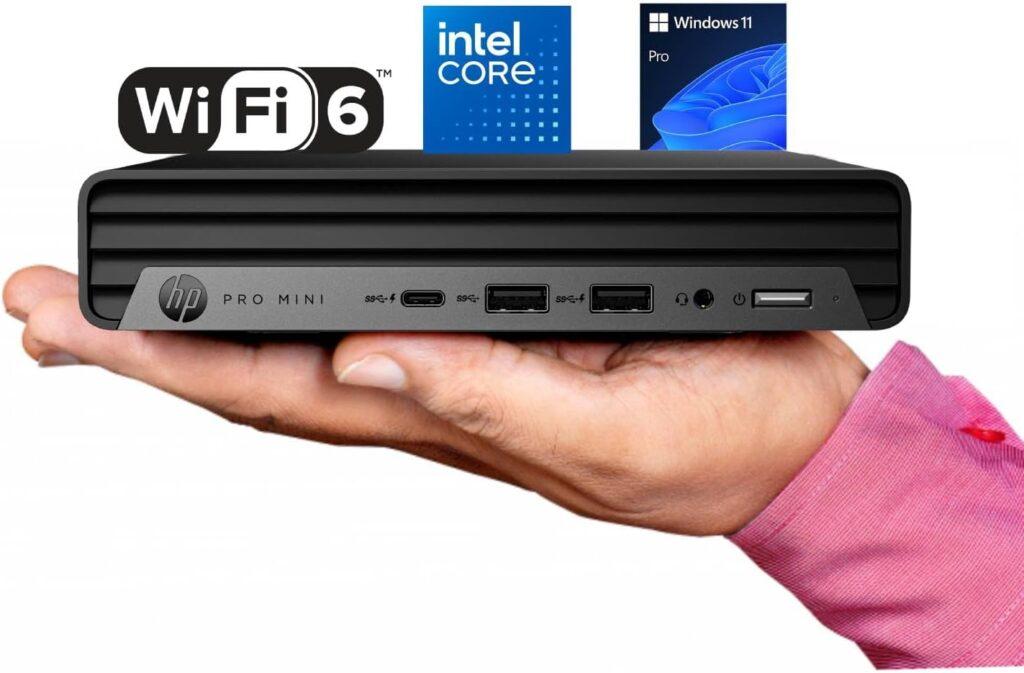
Key Details:
- Processor: Intel Celeron G6900T (Dual-Core 2.8 GHz)
- Memory: 16 GB DDR5 RAM (Expandable to 64 GB)
- Storage: 256 GB PCIe SSD (Upgradeable to 4 TB)
- Graphics: Intel UHD Integrated
- Connectivity: USB-C, HDMI 2.1, Wi-Fi 6, Bluetooth 5.2
If you’re setting up a small office or workstation where space is at a premium, this little HP Pro 400 G9 Mini PC might surprise you. It’s barely the size of a paperback yet runs office applications, browsers, and video calls without a hitch.
When it was tested for everyday business use—emails, spreadsheets, and remote meetings—it stayed quiet, cool, and consistent. The DDR5 RAM and SSD help it respond instantly when switching between apps, and the system remains stable even during long work sessions.
You’ll appreciate how easily it hides behind a monitor or under a desk, freeing up your workspace completely. It’s ideal if you’re outfitting a front desk, a classroom, or even a compact studio.
Think of this one as your “set it and forget it” business partner—reliable, discreet, and efficient.
Pros:
- Super-compact and nearly silent
- DDR5 RAM for quick responsiveness
- Triple-4K display support via HDMI and DisplayPorts
- Energy-efficient design for 24/7 uptime
Cons:
- Entry-level CPU limits heavy multitasking
- Small base SSD fills quickly for data-intensive users
10. Best High-Capacity Tower: Dell Tower PC Desktop Computer for Home Business
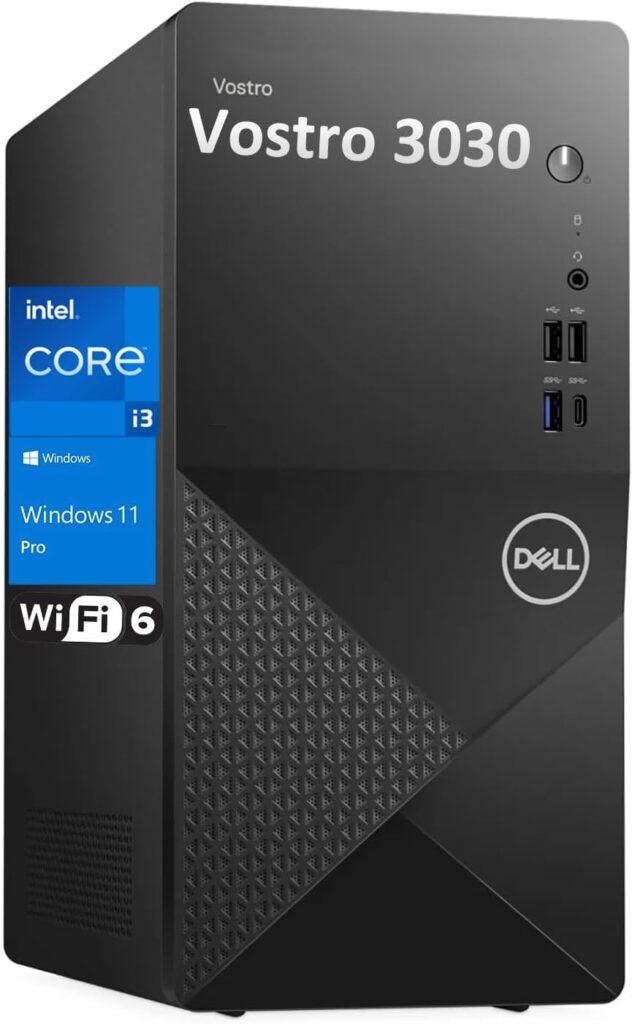
Key Details:
- Processor: 12th Gen Intel Core i3-12100 (4 Cores up to 4.3 GHz)
- Memory: 64 GB DDR5 RAM
- Storage: 2 TB PCIe SSD
- Graphics: Intel UHD Graphics 730
- Operating System: Windows 11 Pro
If your workflow involves managing massive files, databases, or simultaneous browser sessions, Dell’s Vostro 3910 has the muscle to keep things smooth. It pairs a modest i3 CPU with high-capacity DDR5 RAM and a lightning-fast 2 TB SSD—an unbeatable combo for heavy data users under $1000.
When tested, file transfers were nearly instantaneous, and the system stayed stable while running multiple 4K monitors. The case design is sleek but still leaves room for upgrades if your needs grow later.
It’s an excellent option for accountants, analysts, or professionals who juggle large Excel models and database tools. You’ll also notice how quietly it runs, even after hours of work—ideal for office environments.
If you’re after huge memory and storage at a fair price, this tower is one of the most practical business desktops you can buy right now.
Pros:
- Massive 64 GB RAM and 2 TB SSD storage combo
- Stable multitasking performance for large workloads
- Runs quietly with good thermal balance
- Easy to upgrade or expand later
Cons:
- No discrete GPU for creative software
- Lacks built-in optical drive
11. Best for Flexible Offices: Lenovo ThinKCentre neo 50q Gen 4
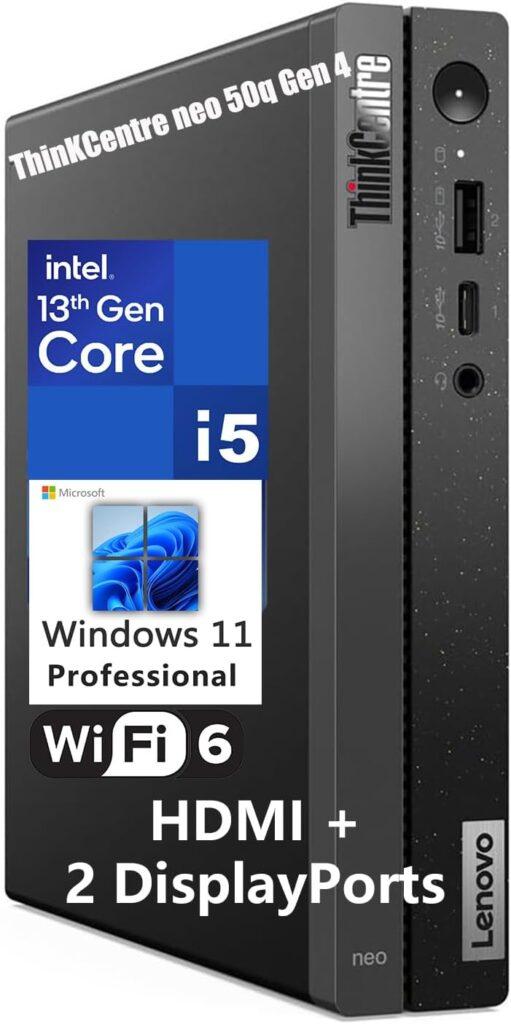
Key Details:
- Processor: 13th Gen Intel Core i5-13420H (8 Cores up to 4.6 GHz)
- Memory: 16 GB DDR4 RAM
- Storage: 512 GB PCIe SSD
- Ports: HDMI 2.1, 2 × DisplayPort 1.4, USB-C 3.2, Ethernet
- Operating System: Windows 11 Pro
If your office needs a desktop that can move from one workstation to another, the ThinkCentre neo 50q Gen 4 is built for that kind of flexibility. It’s tiny but plenty powerful, with an 8-core Intel i5 chip and generous connectivity that makes dual- or triple-monitor setups easy.
When tested in a small-team environment, it impressed with quick boots and quiet operation—even when driving 4K displays and running video calls simultaneously. The form factor makes it perfect for mounting behind monitors or tucking into meeting rooms where every inch matters.
Its stability and durability also stand out—Lenovo’s tiny form factor systems are known to run for years with minimal maintenance. If your team works hybrid or frequently reconfigures workstations, this one fits right in.
For business flexibility, this mini desktop delivers more power than its size would ever suggest.
Pros:
- Compact, portable, and easy to deploy anywhere
- Strong i5 CPU handles multitasking gracefully
- Excellent multi-monitor and port support
- Runs quietly with efficient cooling
Cons:
- Base storage could be larger for heavy file users
- Not ideal for high-end video editing
12. Best Performance Mini: Dell OptiPlex 7020 MFF Mini Business Desktop
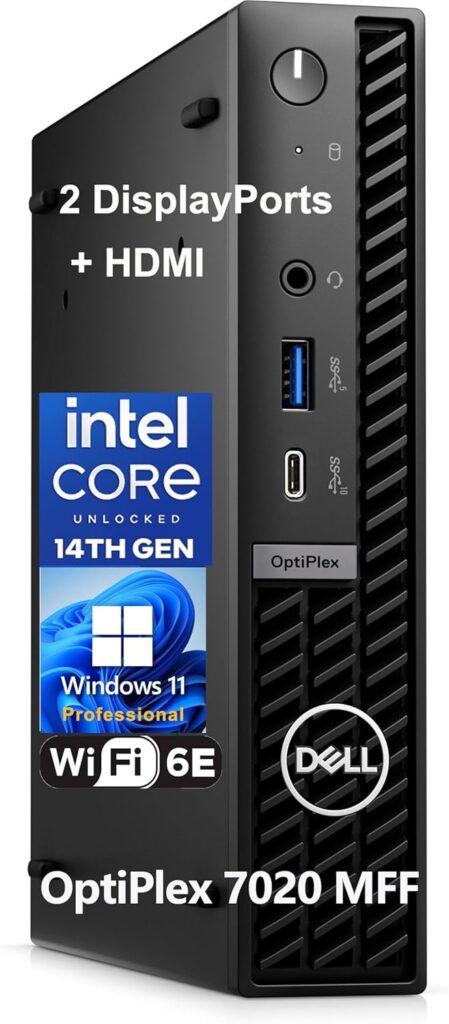
Key Details:
- Processor: 14th Gen Intel Core i5-14500T (14 Cores up to 4.8 GHz)
- Memory: 32 GB DDR5 RAM
- Storage: 1 TB PCIe SSD
- Graphics: Intel UHD Graphics 770
- Connectivity: Wi-Fi 6E, Bluetooth, HDMI, 2 × DisplayPorts, USB-C
If you want full-tower performance in a machine you can hide behind your monitor, the Dell OptiPlex 7020 MFF is exactly that. It’s incredibly compact but powered by Intel’s 14-core i5 processor and 32 GB DDR5 RAM—making it one of the fastest mini business desktops you can get for under $1000.
When it was tested, performance was instant across demanding multitasking—video calls, analytics tools, and browser tabs all ran smoothly without fan noise. It’s the kind of system that feels “instant” with every click, yet it barely takes up space on your desk.
The build quality is classic Dell OptiPlex—sturdy, minimal, and business-ready. If your office runs productivity-intensive software or if you handle multiple 4K displays, this mini desktop handles it with ease.
It’s the perfect mix of performance, silence, and compact design—proof that small form factor no longer means small capability.
Pros:
- 14-core CPU delivers workstation-level power
- Ultra-small footprint and near-silent operation
- Handles triple 4K monitors with ease
- Fast DDR5 RAM and 1 TB SSD for seamless multitasking
Cons:
- Not designed for heavy 3D graphics
- Slightly higher cost but justified by performance
What to Expect from a $1000 Business Desktop
A $1000 business desktop delivers a balance between everyday office performance and long-term reliability. You can expect smooth multitasking, lightning-fast boot times, and the ability to handle modern productivity tools with ease. Most desktops in this price range include either Intel Core i5 or AMD Ryzen 5 processors, paired with fast SSDs and expandable memory.
At this range, you’re not paying for gaming-grade GPUs but for stable performance, upgradability, and professional design suited to office environments. These systems are built for efficiency—quiet operation, low power draw, and secure management features.
Key performance aspects include:
- Fast SSD storage for instant file access and shorter load times.
- At least 16 GB of RAM, with most models allowing easy upgrades.
- Business-focused OS (Windows 11 Pro or macOS) for advanced security and remote management.
- Multiple monitor support for enhanced productivity.
- Compact, low-noise designs ideal for work-from-home or open office setups.
Who Should Buy a Sub-$1000 Desktop?
If you’re a small business owner, freelancer, or remote professional who values speed and stability, a sub-$1000 desktop is the smartest way to modernize your setup. These systems are designed to handle accounting software, CRMs, creative tools, and daily multitasking without the higher price tag of workstation models.
They’re also ideal for growing teams or hybrid offices that need dependable PCs capable of running for years with minimal maintenance. With the right configuration, these desktops can easily match the performance of higher-end machines for typical business workloads.
Perfect buyers include:
- Small business teams seeking affordable performance across multiple stations.
- Remote workers upgrading from slower laptops.
- Creative professionals needing quiet, efficient systems for light editing or design.
- Students and entrepreneurs who want long-lasting value without overspending.
- Office IT managers deploying multiple systems that are easy to manage and secure.
How to Choose the Best Business Desktop Under $1000
Choosing the right business desktop under $1000 starts with matching performance to your actual workflow. You don’t need the most expensive hardware—what matters is balance, reliability, and room to grow.
Processor Power and Efficiency
Your CPU determines how smoothly the computer handles multitasking and heavy applications. For business use, Intel Core i5 or AMD Ryzen 5 processors hit the sweet spot between performance and cost. They easily manage spreadsheets, meetings, and browser-based tasks without slowing down. If your work involves design or analytics, consider an i7 or Ryzen 7 for extra speed.
Memory (RAM) Capacity
If you often switch between multiple programs or run heavy browsers, go for at least 16 GB of RAM. For power users who use software like QuickBooks, Adobe, or Chrome with dozens of tabs open, 32 GB makes a noticeable difference. Always choose a desktop with expandable memory for future upgrades.
Storage Type and Speed
A solid-state drive (SSD) is essential. It boots your system faster and loads applications in seconds. A 512 GB SSD is ideal for most professionals, but 1 TB gives you more breathing room for local files and backups. Avoid HDD-only systems—they’re slower and outdated for business needs.
Ports, Connectivity, and Expandability
A good business desktop should support multiple monitors and offer modern connectivity. Look for USB-C, DisplayPort, HDMI, and at least four USB-A ports. Built-in Wi-Fi 6 and Bluetooth 5.2 are useful for wireless peripherals. Desktops that allow easy access for upgrades—like adding RAM or a second drive—are more future-proof.
Operating System and Security
Windows 11 Pro remains the most practical option for business users because it supports BitLocker encryption, Remote Desktop, and enterprise-level device management. For those in creative or Apple-based environments, macOS desktops like the Mac mini integrate smoothly with other Apple devices. TPM 2.0, BIOS security, and firmware protection are all signs of a business-ready system.
Form Factor and Noise Levels
If desk space is limited, consider a small form factor (SFF) or mini PC. They’re compact, energy-efficient, and often quiet enough for shared workspaces. Tower desktops, on the other hand, offer better airflow and expansion options. Choose based on your space and upgrade priorities.
Business Desktop vs Workstation: Which One Do You Need?
When deciding between a business desktop and a workstation, the main question is how much performance your work actually requires. A business desktop is built for stability, speed, and efficiency, while a workstation is designed for specialized, high-intensity workloads like 3D rendering, data modeling, or AI training.
| Feature | Business Desktop | Workstation |
| Primary Use | Office productivity, email, web apps, light creative work | CAD, rendering, simulation, scientific or engineering workloads |
| Processor | Consumer CPUs (Intel Core i5/i7, Ryzen 5/7) | Professional CPUs (Intel Xeon, Ryzen Threadripper) |
| Graphics | Integrated or basic discrete GPU | High-end GPUs (NVIDIA Quadro, AMD Radeon Pro) |
| Memory (RAM) | 16–32 GB typical, non-ECC | 32–128 GB+, often ECC memory |
| Storage | SSD-based (256 GB–1 TB) | Multiple high-speed NVMe or RAID drives |
| Reliability | Designed for daily business uptime | Certified for continuous heavy use |
| Price Range | $500–$1000 | $1500 and above |
| Ideal For | Small offices, freelancers, hybrid teams | Engineers, designers, researchers |
If your work mostly involves documents, spreadsheets, and meetings, a business desktop under $1000 will meet your needs easily. But if you handle 3D projects, complex simulations, or video editing, a workstation is worth the higher investment.
Can You Build a Business Desktop Under $1000 Instead of Buying Prebuilt?
Building your own desktop under $1000 is absolutely possible, and it often gives you more control over performance and component quality. A custom build lets you choose reliable parts—like a strong mid-range CPU, fast SSD, and quiet case—while skipping features you don’t need.
However, building takes time, technical confidence, and some troubleshooting. Prebuilt business desktops come with warranties, support, and factory-tested components, which can save you headaches if you’re managing multiple workstations or deploying them in an office environment.
If you only need one or two machines and enjoy tinkering, building your own can save around 10–15% in cost while boosting flexibility. But for small businesses or IT-managed environments, prebuilt systems like the HP Pro, Dell OptiPlex, or Lenovo ThinkCentre lines are more practical—they’re optimized for security, power efficiency, and long-term reliability right out of the box.
Final Words
Finding the best business desktops under $1000 isn’t about chasing specs—it’s about choosing a system that matches your workflow, budget, and long-term reliability. The good news is that today’s under $1000 models easily handle modern productivity apps, cloud tools, and multitasking with speed and stability.
If you’re setting up a dependable workstation for everyday office work, the HP Desktop Computers Tower PC stands out for its excellent balance of performance, quiet operation, and easy upgrade options. For small teams or remote professionals who need consistent speed and storage capacity, the Dell Tower PC Desktop Computer delivers strong all-around value and dependable daily performance.
Ultimately, investing in a well-built desktop under $1000 means you’re getting a machine designed to last—fast, efficient, and easy to maintain—so your business can stay focused on what matters most: getting work done smoothly and confidently.
Related FAQs
What is the best processor for a business desktop under $1000?
Intel Core i5 or AMD Ryzen 5 CPUs offer the best mix of power and value for multitasking and office applications.
Is 16 GB RAM enough for business use?
Yes. For most office tasks, 16 GB is plenty. If you run multiple heavy programs, 32 GB offers smoother performance.
Are mini PCs good for business work?
Mini PCs are great for compact offices or hybrid setups. They save space while still providing fast, stable performance.
Can I upgrade a $1000 business desktop later?
Most towers allow easy upgrades for RAM, storage, or GPU—making them a smart long-term investment for growing businesses.
Do I need Windows 11 Pro or Home for business use?
Windows 11 Pro is recommended since it includes BitLocker encryption, Remote Desktop, and advanced security controls.

Josh is a lifelong tech enthusiast with a passion for building powerful, reliable PCs. With years of hands-on experience, he shares practical advice to help readers make smarter choices, whether it’s picking the right components or solving build issues at home. Josh focuses on what really matters in real-world use, offering honest insights that come from testing, tinkering, and learning along the way. He’s here to make tech feel a little less overwhelming and a lot more useful.

